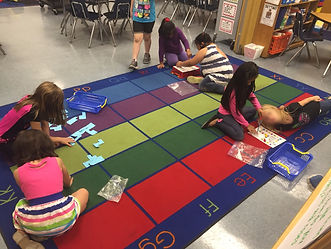SORAYAH G.
FEAPS
1
1
A. Aligns instruction with state-adopted standards at the appropriate level of rigor.
b.Sequences lessons and concepts to ensure coherance and required proir knowledge.
For FEAP 1A, The lessons that I do each day in the classroom are always aligned with state-standards. When planning with the team on Mondays, we use the GCG (General Cirriculum Guide) to plan out what lessons we are doing each day for each subject.Here is a photo of one of my lesson plan guides that are tied to the standard that I taught throughout the week.
For FEAP 1B, For science, there are a lot of vocabulary words. To ensure that they students are understand the vocabulary, I have the students make up their own kinesthetic vocabulary to match the definition of the vocabulary words. In the beginning of lessons that happen the next day, I ask the students what they have learned prior and what movements go with the words that they have learned.


c. Designs instruction for students to achieve mastery
In science, the main thing that my students are learning this year is about living and nonliving things. We have covered this topic in many different types of ways throughout the year. This is allowing the students to master the concept of what makes a living thing living and why nonliving things are not considered alive or ever will be. Now that we are at the year, the student s know that living things need food, air, water, space, and can grow and move on their own. Here is a photo of a recent activity they did in which they create a paper doll that resembles themselves. They had to compare and contrast themselves with the doll and see how even though it was an illustration of themselves it was a nonliving thing.

d. Selects appropriate formative assessments to monitor learning
e. Uses a variety of data, independently and in collaboration with collegues, to evaluate learning
Formative assessments can be very fun and simple for students during lessons. I use my formative assessments to ensure that students are understanding the concepts that I am teaching. For one of my science lessons on the Earth's landforms, I had the students create kinesthetic movements for each landform. Then I had the students make a foldable and draw 4 of the landforms that they have learned about that day. This was two different types of formative assessments. I could see some of the students doing the movements to help them remember how to draw the landforms.
Being in a classroom with 3 other teachers, collaboration is something that we rely on heavily in the classroom. One way that we use data to evaluate the learning outcomes of our students is my formatively assessing how they did after a math lesson. After the students have finished solving a number of problems, we go around a check their work. We look at which problems a lot or some of the students are getting wrong and right lists of what students are making common mistakes. After, we will either stretch out the lesson for another day and use different strategies to teach it or pull a small groups for what students need practice with. Here is a photo of my students engaging in activities that help them stregthen what they need to work on or provide enrichment.


f. develops learning experiences that require students to demonstrate a variety of applicable skillsand competencies
For close-reading modules, we have one performance task for the students to be mindful of all week as we read to different texts. For the most recent close-reading module, we had the students compare and contrast two different texts about plants. The students were asked to make connections between the readings and write about them for their performance task. In their writings, I was looking for multiple things in order for them to get a passing grade. The students had to be mindful of having a topic sentence, supporting details that explain how the plants were different and the same, and a conclusions sentence. They also had to be mindful of spelling their “word wall” words correctly, having proper punctuation, spaces, and for their sentences to be sequential and make sense. In this performance task we looked to see if students could take all that we had taught them in writing this year and apply it to their own.

